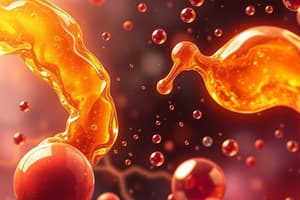Podcast
Questions and Answers
What is produced during each turn of beta oxidation?
What is produced during each turn of beta oxidation?
- 1 Propionyl CoA
- 3 Acetyl CoA
- 2 ATP
- 1 NADH and 1 FADH2 (correct)
How many Acetyl CoA units are produced from the complete oxidation of palmitic acid (16:0)?
How many Acetyl CoA units are produced from the complete oxidation of palmitic acid (16:0)?
- 6
- 9
- 8 (correct)
- 7
What is the total ATP yield from the oxidation of one molecule of palmitic acid?
What is the total ATP yield from the oxidation of one molecule of palmitic acid?
- 125 ATP
- 120 ATP
- 129 ATP (correct)
- 132 ATP
What distinguishes the oxidation of odd-numbered fatty acids like margaric acid (17:0) from even-numbered fatty acids?
What distinguishes the oxidation of odd-numbered fatty acids like margaric acid (17:0) from even-numbered fatty acids?
During the synthesis of fatty acids, where does the process predominantly occur?
During the synthesis of fatty acids, where does the process predominantly occur?
What is a primary role of lipids in biological systems?
What is a primary role of lipids in biological systems?
Which type of lipid is primarily formed from fatty acids and glycerol?
Which type of lipid is primarily formed from fatty acids and glycerol?
Which statement correctly describes fatty acids?
Which statement correctly describes fatty acids?
What is the function of phospholipids in biological systems?
What is the function of phospholipids in biological systems?
What distinguishes eicosanoids from other types of lipids?
What distinguishes eicosanoids from other types of lipids?
Which type of lipid is NOT classified under fatty acids?
Which type of lipid is NOT classified under fatty acids?
What is the significance of beta oxidation in lipid metabolism?
What is the significance of beta oxidation in lipid metabolism?
Which characteristic is true for all lipids?
Which characteristic is true for all lipids?
What role do bile salts play in lipid digestion?
What role do bile salts play in lipid digestion?
Which product is formed from the digestion of triacylglycerols?
Which product is formed from the digestion of triacylglycerols?
What is the main purpose of chylomicrons in lipid transport?
What is the main purpose of chylomicrons in lipid transport?
What is the first step in fatty acid oxidation?
What is the first step in fatty acid oxidation?
Which type of lipoprotein is primarily responsible for transporting triglycerides from the intestines?
Which type of lipoprotein is primarily responsible for transporting triglycerides from the intestines?
What is the main function of lipoproteins?
What is the main function of lipoproteins?
What components are absorbed by intestinal cells after lipid digestion?
What components are absorbed by intestinal cells after lipid digestion?
What happens to odd-numbered carbon fatty acids during catabolism?
What happens to odd-numbered carbon fatty acids during catabolism?
Flashcards
Lipids
Lipids
Organic compounds that are water-insoluble (hydrophobic) but highly soluble in organic solvents.
Hydrophilic vs. Hydrophobic
Hydrophilic vs. Hydrophobic
Hydrophilic: Attracted to water. Hydrophobic: Repelled by water.
Roles of Lipids
Roles of Lipids
Lipids play diverse roles in biological systems.
What are fatty acids?
What are fatty acids?
Signup and view all the flashcards
What is Glycerol?
What is Glycerol?
Signup and view all the flashcards
What is a Triacylglycerol?
What is a Triacylglycerol?
Signup and view all the flashcards
What are Phospholipids?
What are Phospholipids?
Signup and view all the flashcards
What are Steroids?
What are Steroids?
Signup and view all the flashcards
What are lipids?
What are lipids?
Signup and view all the flashcards
What are sphingolipids?
What are sphingolipids?
Signup and view all the flashcards
What are glycolipids?
What are glycolipids?
Signup and view all the flashcards
What are bile acids?
What are bile acids?
Signup and view all the flashcards
What is lipid digestion?
What is lipid digestion?
Signup and view all the flashcards
What happens after lipids are digested?
What happens after lipids are digested?
Signup and view all the flashcards
What is lipid catabolism?
What is lipid catabolism?
Signup and view all the flashcards
Beta-oxidation
Beta-oxidation
Signup and view all the flashcards
Fatty Acid Activation
Fatty Acid Activation
Signup and view all the flashcards
Beta-oxidation Cycle
Beta-oxidation Cycle
Signup and view all the flashcards
Propionyl CoA
Propionyl CoA
Signup and view all the flashcards
Fatty Acid Synthesis
Fatty Acid Synthesis
Signup and view all the flashcards
Study Notes
Lipids Overview
- Lipids are water-insoluble (hydrophobic) molecules, but highly soluble in organic solvents.
- They have both hydrophilic (water-loving) and hydrophobic (water-fearing) parts, this is crucial for their function in biological systems.
Learning Objectives
- Explain structural properties of lipids
- Explain the roles of lipids
- Classify lipids (including fatty acids, steroids, phospholipids, waxes, sphingolipids, triacylglycerides, and others)
- Explain lipid digestion and absorption
- Recognize steroids (e.g., cholesterol, testosterone, estrogen)
- Classify lipoproteins
- Explain fatty acid catabolism (beta-oxidation)
- Explain fatty acid synthesis
Types of Lipids
- Fatty acids: Basic building blocks of many lipids
- Waxes: Contain long-chain fatty acids and alcohols; serve as protective coatings
- Sphingolipids: Important components of cell membranes
- Phospholipids: Key components of cell membranes, form bilayers
- Steroids: Four fused carbon rings, include hormones and cholesterol
- Triacylglycerides (Triglycerides): Store energy
- Terpenes: Important components of many essential oils and pigments
- Eicosanoids: Have diverse roles in cell signaling
Roles of Lipids
- Energy storage: Lipids store energy more efficiently than carbohydrates per gram (needs less water, more efficient energy storage)
- Membrane components: Lipids are essential components of cell membranes
- Signaling molecules: Lipids function as signaling molecules (e.g. hormones).
- Thermal insulation: Lipids provide thermal insulation in animals.
Lipid Digestion
- Digestion: Breaks down large fat molecules into smaller pieces.
- Absorption: Lipids are taken up by the intestinal cells
- Transportation: The products of digestion are transported to other parts of the body
Important Biological Lipids
- Free fatty acids
- Triacylglycerols
- Phospholipids
- Glycolipids
- Steroids
Triacylglycerols
- Triacylglycerol (TAG), also called triglyceride, is a primary energy storage form.
- Composed of glycerol and three fatty acids.
- Formed by dehydration reactions between glycerol and fatty acids.
- Crucial for energy storage in adipose tissue.
Phospholipids
- Glycerophospholipids (phosphoglycerides) and sphingophospholipids (phosphosphingolipids) depend on backbone
- Composed of glycerol, two fatty acids, and a phosphate group.
- Key components of cell membranes because of their dual nature (hydrophobic tails and a hydrophilic head region).
Glycolipids
- Glycolipids are a class of lipids present in cell membranes and are formed by a lipid backbone and carbohydrate groups.
- The carbohydrate groups are crucial for cell-cell recognition and signaling.
Steroids
- Steroids consist of four hydrocarbon rings.
- They have a crucial role as hormones (e.g., estrogen, testosterone) and components of cell membranes (e.g., cholesterol)
Fatty Acids
- Fatty acids are long carbon chains, usually 12-24 carbons in length.
- Typically have a carboxylic acid group.
- Hydrophobic hydrocarbon tail and a hydrophilic head.
- Can be saturated or unsaturated (presence of double bonds)
Lipid Metabolism
- Lipids are broken down (catabolized) for energy.
- Fatty acid oxidation occurs in mitochondria.
- Processes like beta-oxidation are involved in breaking down fatty acids for energy release.
Fatty Acid Synthesis
- Acetyl CoA transport
- Malonyl CoA synthesis
- Elongation of the fatty acid chain
- Lipids are synthesized for storage, cell membranes, or other functions.
Lipoproteins
- Important for lipid transport in the blood
- Different classes of lipoproteins (e.g, Chylomicrons, VLDL, LDL, HDL)
- Lipoproteins are complexes of lipids and proteins to transport lipids through bloodstream
Lipid Catabolism
-
Glycerol is initially catabolized into G-3-P.
-
Specific steps/reactions are involved depending on initial lipid source (fatty acid or glycerol)
- Even length fatty acid chains break down to Acetyl CoA which enters the TCA cycle.
- Odd length fatty acid chains undergo different processes to break down to final components that can enter the TCA cycle.
Lipids in the body
- Important for functions like energy storage, membrane structure, and hormone production
Digestion of dietary lipids
- Dietary lipids undergo digestion, absorption and transportation in the intestine and bloodstream
- Various enzymes and mechanisms (including emulsified breakdown) are involved in reducing lipid size for efficient absorption
Lipid Synthesis
- Synthesis of important biological lipids occurs with specific enzymes and pathways, such as fatty acid synthesis, steroid synthesis etc.
Studying That Suits You
Use AI to generate personalized quizzes and flashcards to suit your learning preferences.




